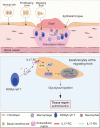IL-17 signaling in skin repair: safeguarding metabolic adaptation of wound epithelial cells
- PMID: 36209253
- PMCID: PMC9547876
- DOI: 10.1038/s41392-022-01202-9
IL-17 signaling in skin repair: safeguarding metabolic adaptation of wound epithelial cells
Conflict of interest statement
The authors declare no competing interests.
Figures

Comment on
-
Interleukin-17 governs hypoxic adaptation of injured epithelium.Science. 2022 Jul 8;377(6602):eabg9302. doi: 10.1126/science.abg9302. Epub 2022 Jul 8. Science. 2022. PMID: 35709248 Free PMC article.
References
Publication types
MeSH terms
Substances
LinkOut - more resources
Full Text Sources

